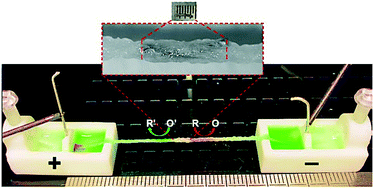Wireless bipolar electrode-based textile electrofluidics: towards novel micro-total-analysis systems†
Abstract
Point of care testing using micro-total-analysis systems (μTAS) is critical to emergent healthcare devices with rapid and robust responses. However, two major barriers to the success of this approach are the prohibitive cost of microchip fabrication and poor sensitivity due to small sample volumes in a microfluidic format. Here, we aimed to replace the complex microchip format with a low-cost textile substrate with inherently built microchannels using the fibers' spaces. Secondly, by integrating this textile-based microfluidics with electrophoresis and wireless bipolar electrochemistry, we can significantly improve solute detection by focusing and concentrating the analytes of interest. Herein, we demonstrated that an in situ metal electrode simply inserted inside the textile-based electrophoretic system can act as a wireless bipolar electrode (BPE) that generates localized electric field and pH gradients adjacent to the BPE and extended along the length of the textile construct. As a result, charged analytes were not only separated electrophoretically but also focused where their electrophoretic migration and counter flow (EOF) balances due to redox reactions proceeding at the BPE edges. The developed wireless redox focusing technique on textile constructs was shown to achieve a 242-fold enrichment of anionically charged solute over an extended time of 3000 s. These findings suggest a simple route that achieves separation and analyte focusing on low-cost surface-accessible inverted substrates, which is far simpler than the more complex ITP on conventional closed and inaccessible capillary channels.



 Please wait while we load your content...
Please wait while we load your content...